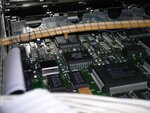jalves_pt
Junior Member level 1
Brad,
Your answer was like a cold water bath
I press, I flex, I twist with no avail.
But when I am using the ice cube, I have to press down the ice firmly and a good couple of seconds in order to bring back the CH2 trace in the display, which lead me to think that something was loose (wich I couldn't confirm pressing and twisting the chip and the board).
Also this particular chip senses to my finger has hotter than the rest of the other chips around (with exception of the chips in the hybrid input attenuator that both channels chips run equal or hotter than this one) in the main board.
But the higher voltage in any of its pins is +4.99V...
At the moment don't know what to think or if I invest more time in this.
This particular chip is a "IC ASIC:BIPOLAR, Linear, channels switch" , could some parasitic capacitance be held responsible for the CH2 switch off?
Also do you have any clue regarding the identification of the component you point (the one looking like a big cap with the side tinted red)??
Your answer was like a cold water bath
I press, I flex, I twist with no avail.
But when I am using the ice cube, I have to press down the ice firmly and a good couple of seconds in order to bring back the CH2 trace in the display, which lead me to think that something was loose (wich I couldn't confirm pressing and twisting the chip and the board).
Also this particular chip senses to my finger has hotter than the rest of the other chips around (with exception of the chips in the hybrid input attenuator that both channels chips run equal or hotter than this one) in the main board.
But the higher voltage in any of its pins is +4.99V...
At the moment don't know what to think or if I invest more time in this.
This particular chip is a "IC ASIC:BIPOLAR, Linear, channels switch" , could some parasitic capacitance be held responsible for the CH2 switch off?
Also do you have any clue regarding the identification of the component you point (the one looking like a big cap with the side tinted red)??
